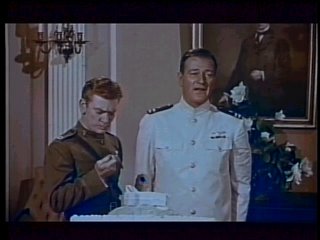John Ford's THE WINGS OF EAGLES (1957)

John Ford immortalizes Frank Wilbur “Spig” Wead, a United States Navy aviator who became a screenwriter after an unfortunate spinal injury forced him to subdue his daredevil-like persona (as seen during the frenetically paced opening sequence, in which a newly enlisted Wead – played by John Wayne – checks out a biplane without permission and lands it in the middle of Fordian celebration). What’s especially touching about this portrait of Wead - and makes it different from any other biopic - is the fact that the man depicted was a personal friend of Ford, and even more, died in the arms of the director.
I jotted down some notes during the viewing, so I’ll post some observations and remarks in bullet form, a habit I’d rather like to continue here on this blog:
--Maureen O’Hara, who plays Min Wead, “Star-Spangled Spig”’s wife, crosses her arms left-to-right in a gesture not unlike the Harry Carey, Sr. tribute in those famous closing moments of THE SEARCHERS in the scene after her first baby dies of a fever. The composition, which features Wayne’s profile in darkness on the right side of the screen, as O’Hara emerges in the background of another room, is startling in its beauty, and raw emotionality.
--I’ve read elsewhere, in Peter Bogdanovich’s short interview book and Tag Gallagher’s immense, indispensable “John Ford: The Man and His Films”, that Ford didn’t belabor himself with setting the film in its correct time period (shortly before WWI and ending in the middle of WWII), and it’s easy to see. The film looks modern (1957) in its set design, clothing, and all other areas of décor. Ford also told Bogdanovich that his intent was to make it as quickly paced as possible in the beginning, and then to ease off gradually, subduing the action scenes and chaotic, but playful jocularity amongst the Navy and Army (as represented by red-haired character actor Kenneth Tobey, as Herbert Allen Hazard), and it does accomplish all of this by the first hour, before tragedy befalls Wead.
--Ford’s preoccupation with how systems and regiments work are well represented here. And these men, Wead and his fellow servicemen, are only truly at home when they’re working for Uncle Sam. Wead’s wife recognizes and reconciles with this in a powerful scene near the finale, after Pearl Harbor has been announced. Wead, through a telephone conversation, expresses his need to try to pull some strings in order to get back in and serve his country, despite finally having worked out his domestic problems. O’Hara holds her tongue, but attacks her record player after the call is finished. Note that ‘Jughead’ Carson (Dan Dailey) can’t make it in the outside world either, with his failed chicken ranch and dead-end job as a lowly cab driver forcing him to reenlist for WWII. Jughead even keeps his Navy cap on in the hospital, forever pledging his commitment to his country.
--Tarantino surely stole the “I’m gonna move that big toe” scene for KILL BILL, VOL. 1, although in a completely different context.
--The final moments made me cry. As Wead walks past all of the familiar faces on his way off the Naval ship, after having been told his time left on earth is fairly short (“either three days, three weeks, or three years”, his Doctor tells him), he’s buckled in and you can’t help but feel for him as he realizes he’s served his very last moments as a Commanding Officer.
Incidentally, I also re-watched FORT APACHE, the first in Ford’s Calvary trilogy today. But that’s for another time, maybe after taking a closer look alongside SHE WORE A YELLOW RIBBON (my favorite) and RIO GRANDE.
Labels: John Ford




2 Comments:
I haven't seen The Wings of Eagles, but I adore She Wore a Yellow Ribbon.
I often find myself singing the theme song, as it happens.
Like Matt, I also haven't seen The Wings of Eagles (yet; it sounds like it'd have many similarities to The Long Gray Line) but love She Wore a Yellow Ribbon ... and also Fort Apache, which I recently revisited, myself. Good post, Aaron.
Post a Comment
<< Home